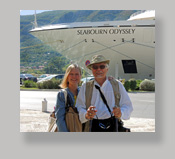 
VENICE | CROATIA | MONTENEGRO | CORFU | KAFALONIA | PYLOS | NAFPLION | PIRAEUS | MILOS | MYKONOS PATMOS | KUSADASI | CHIOS | ISTANBUL DAY 1 | ISTANBUL DAY 2 | ISTANBUL DAY 3 | TRAVEL REFLECTIONS |
 
VENICE | CROATIA | MONTENEGRO | CORFU | KAFALONIA | PYLOS | NAFPLION | PIRAEUS | MILOS | MYKONOS PATMOS | KUSADASI | CHIOS | ISTANBUL DAY 1 | ISTANBUL DAY 2 | ISTANBUL DAY 3 | TRAVEL REFLECTIONS |
ISTANBUL, day 2 10-7-12
A really great day of touring. Lots of things made it different. For one we are in a large city that has been the capital of much of the world at one time or other and has centuries of history and culture. The place has one site after another so even just hitting a sampling of the highlights a sightseeing day can be varied and full. We started the day at Topkapi. This is the original palace of the Sultan, Suleyman the Magnificent. The palace was located in an area hundreds of acres in size. It was described as being like the Forbidden City in China in that there were several portals that one had to pass through to get to the inner Palace and to the Sultan. There were gates and mosques and gardens and layers of residential and governmental structures. The thing that everyone goes to see is the treasury rooms. Our guide got us to the Palace early so we beat the crowds. And crowds there were. Our stroll through the various rooms that held the treasures ended us with the jewel room that contained the famous dagger with huge emeralds. The dagger was originally displayed in the center of the room but, as in the movies, thieves tried to defeat the alarm systems by coming down from the ceiling. They were foiled by a bird that flew into the room while the heist was going on and tripped the alarm. In addition to the dagger was one of the largest diamonds in the world, 62 carats. We then went deep into the Palace and through various rooms and corridors to the Harem. The Harem was the family as opposed to the administrative section of the palace. It had a training school for young women and had its own schools for children both of the Sultan and other royal families. There were kitchens that fed thousands every day (this included poor people from outside the palace walls) and there were also hospitals and other service areas on the palace grounds. The Harem was divided into various sections for favorite wives, those who produced children, those who produced male children, and the biggest area of all for the Queen Mother. The bedrooms and sitting areas and other perks were divided up on the basis of this favor. The Sultan's quarters, no surprise, were the most elegant. The rest of the Palace had rooms where dignitaries were met, gardens for leisure, and mosques for prayer. We then went to a spice market. We like markets because it is a place where the locals hang out. This market had spices but was alive with all sorts of household items and junk. Fun and colorful. We had lunch in a place that sounded Italian, Mezzaluna, but which featured Turkish dishes. The various appetizers and main courses were featured behind glass and you told the waiter what you wanted and it was brought to the table. The stuffed grape leaves were particularly good but I passed on a dish that CC ordered which was small sardines wrapped around a mixture of rice, currents and dill.
|